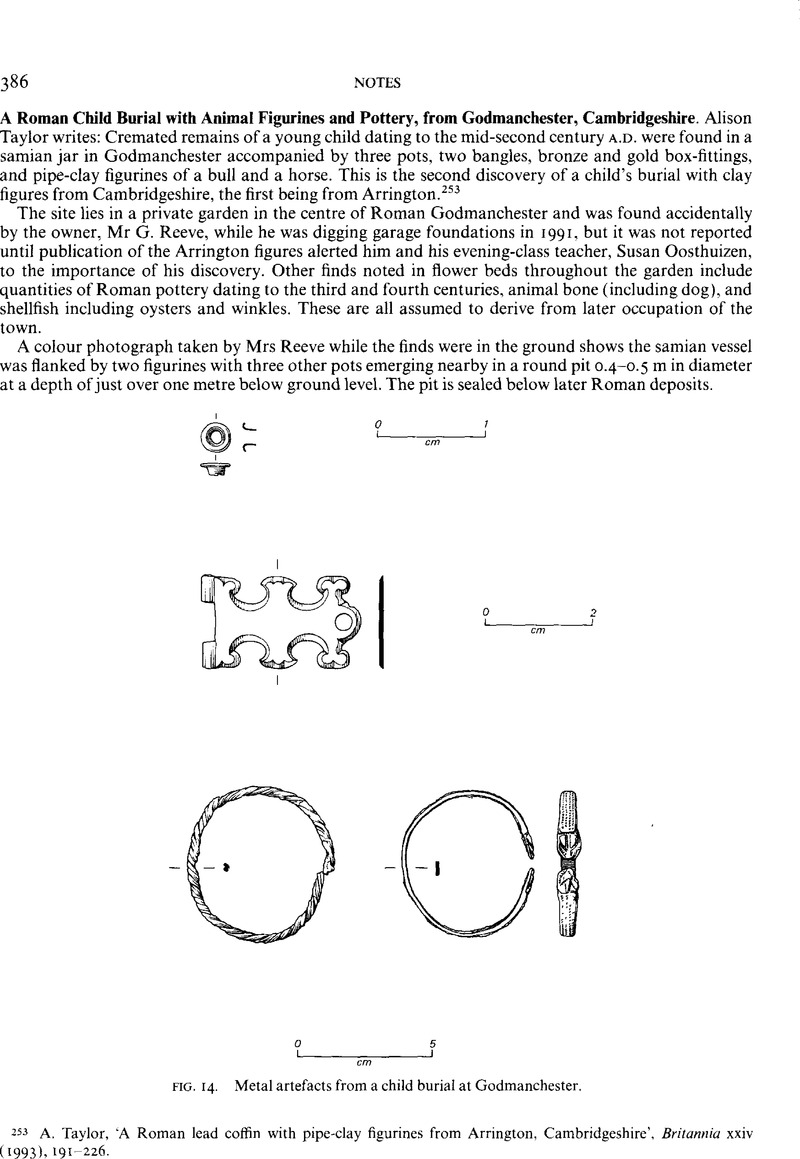Published online by Cambridge University Press: 09 November 2011

253 Taylor, A., ‘A Roman lead coffin with pipe-clay figurines from Arrington, Cambridgeshire’, Britannia xxiv (1993), 191–226.CrossRefGoogle Scholar
254 Pers. comm. Christine Jones, Colchester & Essex Museum, July 1993.
255 M. Rouvier-Jeanlin, Les figurines gallo-romaines en terre-cuite au Musée des Antiquités Nationales, XXIVe supplément à Gallia (1972), no. 1028.
256 M.J. Green, The Religions of Civilian Roman Britain, BAR Brit. Ser. 24 (1976), 217, pl. xixa, b; M.J. Green, The Gods of the Celts (1986), 191, fig. 84.
257 M.J. Green, Symbol and Image in Celtic Religious Art (1989), 181, fig. 82.
258 Rouvier-Jeanlin, op. cit. (note 255), Type 1, Groupe C, no. 976.
259 Green, op. cit. (note 256), 231, pl. xxie; Jenkins, F., ‘The horse-deity of Roman Canterbury’, Arch. Cant., lxxvii (1962), 142ff.Google Scholar
260 Green, op. cit (note 256), 164, pl. xxig.
261 ibid., 211, pl. iie.
262 F. Jenkins, ‘Some interesting types of clay statuettes of the Roman period found in London’, in J. Bird et al. (eds), Collectanea Londinensia (1978), 149–62.
263 M.J. Green, Animals in Celtic Life and Myth (1992), 204-10.
264 ibid., 220-4, esp. 223, fig. 8.21.
265 ibid., 234-8.
266 J.-L. Brunaux, The Celtic Gauls: Gods, Rites and Sanctuaries (1988); P. Meniel, Chasse et elèvage chez les Gaulois (1987).
267 M.J. Green, Dictionary of Celtic Myth and Legend (1992), 51-2; T. Kinsella, The Tain (1969).
268 Green, op. cit. (note 263), 66-91.
269 T.P. Pick and R. Howden (eds), Gray's Anatomy (Anatomy, descriptive and surgical) (American ed. from 15th Englished., 1988).
270 Walker, F.G., ‘Greek coins and Syrian arrowheads dug up in a Roman cemetery in Godmanchester’, Proc. Camb. Ant. Soc. xiii (1909), 282–90.Google Scholar
271 H.J.M. Green, ‘Roman Godmanchester’, in W. Rodwell and T. Rowley (eds), Small Towns in Roman Britain, BAR 15 (1975), 183-210.
272 Rankov, N.B., ‘Roman Britain in 1981’, Britannia xiii (1982), 363.Google Scholar
273 G.T. Rudd, pers. comm, and the author's observations.
274 L. Hoyland and G. Wait, Roman Burials at London Street, Godmanchester (1992).
275 T. Reynolds, Roman Burials and Settlement Remains at The Parks, Godmanchester (1992).
276 R.A. Philpott, Burial Practices in Roman Britain, BAR 219 (1991).
277 F. McAvoy (interim report), Godmanchester, Rectory Farm (1990).
278 M.J. Green in Taylor, op. cit. (note 253), 212-25.
279 Green, op. cit. (note 271), 196.
280 ibid.
281 S. Esmonde Cleary, ‘Town and country in Roman Britain?’ in S. Bassett (ed.), Death in Towns (1992), 32.
To send this article to your Kindle, first ensure no-reply@cambridge.org is added to your Approved Personal Document E-mail List under your Personal Document Settings on the Manage Your Content and Devices page of your Amazon account. Then enter the ‘name’ part of your Kindle email address below. Find out more about sending to your Kindle. Find out more about saving to your Kindle.
Note you can select to save to either the @free.kindle.com or @kindle.com variations. ‘@free.kindle.com’ emails are free but can only be saved to your device when it is connected to wi-fi. ‘@kindle.com’ emails can be delivered even when you are not connected to wi-fi, but note that service fees apply.
Find out more about the Kindle Personal Document Service.
To save this article to your Dropbox account, please select one or more formats and confirm that you agree to abide by our usage policies. If this is the first time you used this feature, you will be asked to authorise Cambridge Core to connect with your Dropbox account. Find out more about saving content to Dropbox.
To save this article to your Google Drive account, please select one or more formats and confirm that you agree to abide by our usage policies. If this is the first time you used this feature, you will be asked to authorise Cambridge Core to connect with your Google Drive account. Find out more about saving content to Google Drive.